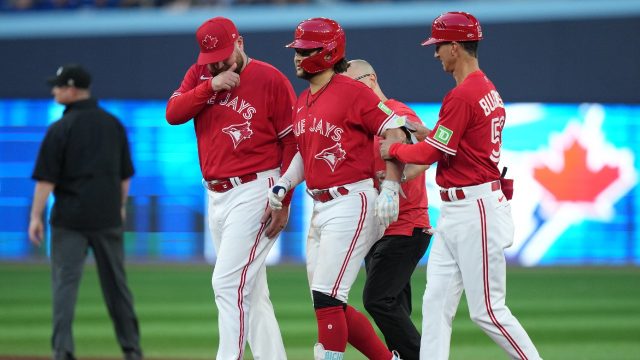
TORONTO – As if the trade deadline didn’t offer enough suspense, one of the Blue Jays’ most important players left the field after aggravating his knee Monday.
In an unexpected twist, the status of Bo Bichette looms large over the Blue Jays’ deadline plans. Internally, the Blue Jays know more than we do, but as far as the public is aware Bichette’s still being evaluated after leaving Monday’s game due to right knee discomfort.
“We’re still gathering information to see what we’re going to do next,” said Blue Jays manager John Schneider. “We’ll probably know more (Tuesday).”
Now, the question becomes: will that discomfort ease, allowing Bichette to return to action soon, or is he due for a longer absence? Whether or not they share that information, the Blue Jays must determine everything they can on that front.
And regardless of Bichette’s status, the Blue Jays have work to do. The addition of Jordan Hicks reinforces a bullpen that has a chance to be among the league’s best, but there was always going to be room for another bat on this team. By the sounds of it, the Blue Jays are actively looking to add one.
“We’re working around the clock,” GM Ross Atkins said Monday afternoon, speaking in general terms. “Not a lot of downtime for us right now.”
With time ticking down until Tuesday’s 6 p.m. ET trade deadline, here’s a look at some pressing questions the Blue Jays must consider…
WHAT OPTIONS EXIST AT SHORTSTOP?
Of the rumoured trade candidates, pending free agent Tim Anderson is the biggest-name shortstop available, but it was just a month ago that he dealt with shoulder soreness and briefly moved to second base, where the throw to first is shorter. Whether it’s related to his shoulder or not, Anderson has also seen a significant drop-off in power this year with only one home run and just 11 doubles.
To be fair, Anderson’s been hitting much better of late, with an .829 OPS in 15 games since the all-star break, but any interested team would be taking on risk here.
Interestingly, Atkins said the Blue Jays “did exchange bigger concepts and (talk) about several (Cardinals) players” before narrowing the scope of the trade for Hicks. In theory, that could have included discussions about Paul DeJong or even Tommy Edman, both of whom have spent significant time at shortstop this year. Those are names to revisit Tuesday if Bichette’s likely to miss time.
And as long as we’re speculating, what about J.P. Crawford of the Mariners? It’s likely a reach, but these are the sorts of names the Blue Jays must consider internally.
Internally, the Blue Jays could turn to Santiago Espinal, who replaced Bichette at shortstop Monday night. Yet the 2022 all-star has seen his numbers drop off this year, with a .228/.299/.315 batting line and questionable defensive numbers including an 11th percentile outs above average ranking and -1.9 runs of defensive value, as measured by FanGraphs (keep in mind, shortstop is more demanding than second, where Espinal has played most of his innings).
Simply put, none of the alternatives are ideal here. There’s no replacing Bichette with anyone but Bichette. Hopefully, for the Blue Jays, he can return before long.
WHAT’S NEXT FOR THE JAYS?
Even before Bichette went down, the Blue Jays needed another bat. Ideally, the Blue Jays would deepen their bench with a player who could start against lefties, pinch-hit late in games and start for an extended period if injury were to strike elsewhere on the roster. A rental like Tommy Pham would make some sense as the cost would be lower and it would allow the Blue Jays to reset after the season.
In a market with few sellers, the cost could still be high but despite trading pitching prospects Sem Robberse and Adam Kloffenstein to St. Louis for Jordan Hicks, Atkins believes he has enough prospects to continue adding. When asked whether the deal with the Cardinals would limit the Blue Jays, the GM suggested otherwise.
“I don’t think so at all,” Atkins said. “We’re in a strong position.”
But identifying the need is the easy part. Far more difficult – but still necessary – landing a player at a time that more teams are buying than selling. It won’t be easy, and will require more prospect inventory, but the payoff of a deeper roster should be worth it.
WHAT WILL THE ORIOLES DO?
By trading for Aaron Civale Monday, the Rays augmented a rotation that’s been weakened by injury. They paid a high price in well-regarded first base prospect Kyle Manzardo, but at least they addressed their biggest need.
The division-leading Orioles have been relatively quiet, however. Earlier this month they acquired hard-throwing right-hander Shintaro Fujinami, but otherwise, they’ve left their roster alone.
Lately, it’s been working, with a 17-9 record in July that’s landed them in first place. And their GM, Mike Elias, has been notably disciplined in building this roster into a contender, holding prospects and avoiding risky free agent deals (before joining the Orioles he was a high-ranking Astros executive during their rebuild).
So will the Orioles act more aggressively this year in an attempt to hold off the likes of the Rays and Blue Jays? Or will Elias stay disciplined, delaying gratification instead of prioritizing 2023? If you’re the Rays and the Blue Jays, you’re probably hoping the Orioles stand pat. But it wouldn’t be a surprise if Baltimore found a way to add an arm without trading away the best of their prospects.
One way or another the Orioles’ decisions will impact the Blue Jays – starting Tuesday when the two teams continue their head-to-head matchup at Rogers Centre.







